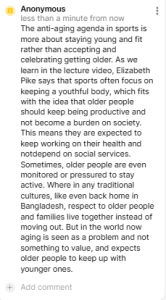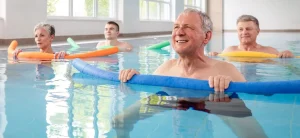6
Section One: The Fundamentals
A) Keywords
Exercise 1:
Provide a brief definition of one of the padlet keywords for this week.

The anti-aging agenda in sports is more about staying young and fit rather than accepting and celebrating getting older. As we learn in the lecture video, Elizabeth Pike says that sports often focus on keeping a youthful body, which fits with the idea that older people should keep being productive and not become a burden on society. This means they are expected to keep working on their health and notdepend on social services. Sometimes, older people are even monitored or pressured to stay active. Where in any traditional cultures, like even back home in Bangladesh, respect to older people and families live together instead of moving out. But in the world now aging is seen as a problem and not something to value, and expects older people to keep up with younger ones.
|
B) The Social Significance of Aging in Sport
Exercise 2: Notebook Prompt
How is old age popularly represented today? Find an image online that you think exemplifies one defining attitude towards old age and paste in your notebook below with a brief explanation of what this image means to you.

When I came to Canada, I was surprised by how normal it was for some people to send their parents to old age homes and not visit them for years. In my culture, we usually take care of our elders at home and see it as a way to show love and respect. So seeing older people living apart from their families felt a bit like they were being left behind. I understand that care homes can provide important support, but it still felt like a cultural shock to see how aging can sometimes lead to loneliness or being forgotten. But the more I talked to people here, the more I understood that care homes can offer safety, medical care, and a social environment for older adults. It helped me see that some families choose this out of love and concern, not neglect. Still, I can not help but feel sad knowing many elders spend their final years away from their children. That emotional distance feels very different from how aging is treated in my culture.
|
Exercise 3: Notebook Prompt
What does the article (referencing another study by Dionigi) mean by its statement that sport can help aging people to simultaneously “accept and resist the ageing process” (572)? Respond by audio or text and find paste two images sourced online into your notebook showing how sport might help aging people to both accept and resist the aging process.
Exercise 4: Notebook Prompt
Who are the groups less likely to have extensive opportunities to take part in sports, according to Pike? How does privilege factor into aging and sport? (200 words max)
 
According to the article, which cites Dionigi’s research, athletics helps in older adults’ acceptance and resistance to aging. Although these two concepts may appear to be mutually exclusive, they are in fact complementary. Engaging in physical activity helps older persons recognize their limitations while simultaneously pushing past them.Elderly people might not be as strong or move as quickly as they once were. However, this does not imply that they should halt their progress. Also, they can select activities that are appropriate for their skill level. An excellent example is the first picture, which depicts senior citizens exercising in the water at a swimming pool. Swimming promotes balance, reduces joint discomfort, and is easy on the body. It enables elderly individuals to maintain their happiness and health while respecting their bodies’ limited capabilities. On the other hand, resisting aging means fighting the idea that older people should slow down or stop being active. Many still do hard sports like running or biking. In the second image, we see an older man running in a race. He looks strong and focused. This shows that aging does not mean giving up. It proves older people can still have goals, stay active, and feel proud. |
Exercise 5: Padlet Discussion
Why do you think age discrimination is “reported more than any form of prejudice” with older people presented as a threat to social values and interests? Feel welcome to use video in your responses. Paste your comments (or transcript of your video) below!
| Age discrimination is reported more than other types because it happens often and people do not always notice it. Many people believe it’s acceptable to make fun of or disregard elderly folks. Some individuals view older folks as a problem. Some people believe they prevent change or utilize healthcare excessively. They appear to be a burden because of this. The media portrays youth more. It portrays older people as slow or weak. There is also a discrimination in old people driving cars, whenever they are involved in an accident, it is the main focus, where there are actually younger people getting into more crashes. Because of this, individuals treat older persons unfairly and are afraid of growing old. |
B) Older Women and Sport
Exercise 6: Notebook Prompt
What differences do you see in these ads? Which one is more inclusive? How is age represented or not represented in each? Answer these questions in your notebook.
| Both ads talk about being inclusive and tackle the issues around age in sports, but they are also different in their own ways. You Can’t Stop Us features powerful athletes from throughout the globe. It talks about power, collaboration, and never giving up while using a split screen to mirror their motions. It includes people who have a range of talents, genders, and ethnic backgrounds. Though it can be said it focused more on younger athletes. The second ad shows women getting back into exercise after big life changes like having kids, getting older, or being sick. It shows women of all ages and body shapes. Some are older, and some are just starting to move again. Age is more represented in this one compared to the Nike’s ad. For me, You Can’t Stop Us is more inclusive because it shows people of all genders, backgrounds, and abilities coming together through sport. It sends a strong message that everyone belongs, no matter who they are or where they come from. |
Exercise 7: Notebook Prompt
In her article, “Assessing the sociology of sport: On age and ability,” Elizabeth Pike references a “trend towards a ‘feminisation of ageing’, with many women living longer than men” (573). Do you agree that aging has been “feminized” in this way? How? Answer these questions in your notebook.
| I agree with this, when we look at old age homes or health ads, we often see more older women than men. This is because women usually live longer, but they also may live alone after their husbands pass away. As highlighted by Pike, older women may not always have the same opportunities to participate in sports or maintain an active lifestyle. One of the reasons is because they are still frequently required to care for family members, such as elderly parents or grandchildren. Women are also under increased pressure to maintain a youthful appearance and to keep their desires for themselves. Women may find aging more difficult as a result of these factors. This also plays into the anti ageing agenda that I used for my keyword for this chapter.
|
Section Three: Module Mini Assignment
| I am doing Major Assignment from this Chapter instead.
|

